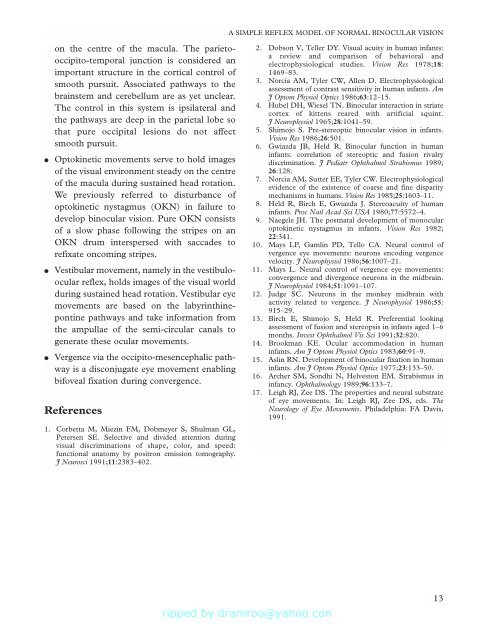Strabismus - Fundamentals of Clinical Ophthalmology.pdf
Strabismus - Fundamentals of Clinical Ophthalmology.pdf
Strabismus - Fundamentals of Clinical Ophthalmology.pdf
Create successful ePaper yourself
Turn your PDF publications into a flip-book with our unique Google optimized e-Paper software.
A SIMPLE REFLEX MODEL OF NORMAL BINOCULAR VISION<br />
●<br />
●<br />
●<br />
on the centre <strong>of</strong> the macula. The parietooccipito-temporal<br />
junction is considered an<br />
important structure in the cortical control <strong>of</strong><br />
smooth pursuit. Associated pathways to the<br />
brainstem and cerebellum are as yet unclear.<br />
The control in this system is ipsilateral and<br />
the pathways are deep in the parietal lobe so<br />
that pure occipital lesions do not affect<br />
smooth pursuit.<br />
Optokinetic movements serve to hold images<br />
<strong>of</strong> the visual environment steady on the centre<br />
<strong>of</strong> the macula during sustained head rotation.<br />
We previously referred to disturbance <strong>of</strong><br />
optokinetic nystagmus (OKN) in failure to<br />
develop binocular vision. Pure OKN consists<br />
<strong>of</strong> a slow phase following the stripes on an<br />
OKN drum interspersed with saccades to<br />
refixate oncoming stripes.<br />
Vestibular movement, namely in the vestibuloocular<br />
reflex, holds images <strong>of</strong> the visual world<br />
during sustained head rotation. Vestibular eye<br />
movements are based on the labyrinthinepontine<br />
pathways and take information from<br />
the ampullae <strong>of</strong> the semi-circular canals to<br />
generate these ocular movements.<br />
Vergence via the occipito-mesencephalic pathway<br />
is a disconjugate eye movement enabling<br />
bifoveal fixation during convergence.<br />
References<br />
1. Corbetta M, Miezin FM, Dobmeyer S, Shulman GL,<br />
Petersen SE. Selective and divided attention during<br />
visual discriminations <strong>of</strong> shape, color, and speed:<br />
functional anatomy by positron emission tomography.<br />
J Neurosci 1991;11:2383–402.<br />
2. Dobson V, Teller DY. Visual acuity in human infants:<br />
a review and comparison <strong>of</strong> behavioral and<br />
electrophysiological studies. Vision Res 1978;18:<br />
1469–83.<br />
3. Norcia AM, Tyler CW, Allen D. Electrophysiological<br />
assessment <strong>of</strong> contrast sensitivity in human infants. Am<br />
J Optom Physiol Optics 1986;63:12–15.<br />
4. Hubel DH, Wiesel TN. Binocular interaction in striate<br />
cortex <strong>of</strong> kittens reared with artificial squint.<br />
J Neurophysiol 1965;28:1041–59.<br />
5. Shimojo S. Pre-stereoptic binocular vision in infants.<br />
Vision Res 1986;26:501.<br />
6. Gwiazda JB, Held R. Binocular function in human<br />
infants: correlation <strong>of</strong> stereoptic and fusion rivalry<br />
discrimination. J Pediatr Ophthalmol <strong>Strabismus</strong> 1989;<br />
26:128.<br />
7. Norcia AM, Sutter EE, Tyler CW. Electrophysiological<br />
evidence <strong>of</strong> the existence <strong>of</strong> coarse and fine disparity<br />
mechanisms in humans. Vision Res 1985;25:1603–11.<br />
8. Held R, Birch E, Gwiazda J. Stereoacuity <strong>of</strong> human<br />
infants. Proc Natl Acad Sci USA 1980;77:5572–4.<br />
9. Naegele JH. The postnatal development <strong>of</strong> monocular<br />
optokinetic nystagmus in infants. Vision Res 1982;<br />
22:341.<br />
10. Mays LP, Gamlin PD, Tello CA. Neural control <strong>of</strong><br />
vergence eye movements: neurons encoding vergence<br />
velocity. J Neurophysiol 1986;56:1007–21.<br />
11. Mays L. Neural control <strong>of</strong> vergence eye movements:<br />
convergence and divergence neurons in the midbrain.<br />
J Neurophysiol 1984;51:1091–107.<br />
12. Judge SC. Neurons in the monkey midbrain with<br />
activity related to vergence. J Neurophysiol 1986;55:<br />
915–29.<br />
13. Birch E, Shimojo S, Held R. Preferential looking<br />
assessment <strong>of</strong> fusion and stereopsis in infants aged 1–6<br />
months. Invest Ophthalmol Vis Sci 1991;32:820.<br />
14. Brookman KE. Ocular accommodation in human<br />
infants. Am J Optom Physiol Optics 1983;60:91–9.<br />
15. Aslin RN. Development <strong>of</strong> binocular fixation in human<br />
infants. Am J Optom Physiol Optics 1977;23:133–50.<br />
16. Archer SM, Sondhi N, Helveston EM. <strong>Strabismus</strong> in<br />
infancy. <strong>Ophthalmology</strong> 1989;96:133–7.<br />
17. Leigh RJ, Zee DS. The properties and neural substrate<br />
<strong>of</strong> eye movements. In: Leigh RJ, Zee DS, eds. The<br />
Neurology <strong>of</strong> Eye Movements. Philadelphia: FA Davis,<br />
1991.<br />
13










![SISTEM SENSORY [Compatibility Mode].pdf](https://img.yumpu.com/20667975/1/190x245/sistem-sensory-compatibility-modepdf.jpg?quality=85)





